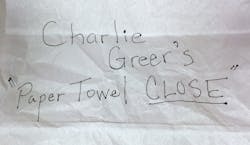COMFORTECH PREVIEW: Charlie Greer's 'Paper Towel Close'
Editor’s Note: Charlie is in the midst of a year-long series describing his procedure on running service calls. Read this one closely. There's much to be learned in the smallest details.
FIND OTHER articles in this series at: bit.ly/CGRunningtheCall / bit.ly/CGTheInspection / bit.ly/CGTheTuneUpCall
When running repair calls, just like maintenance calls, you'll do a complete inspection, including checking the cleanliness of the indoor blower and coil. You're not doing anyone a favor by getting their equipment running, but leaving their coils dirty.
WANT TO BEAT LOW-BIDDERS IN HVAC REPLACEMENT SALES? HEAR FROM CHARLIE GREER AT COMFORTECH 2016!
You'll remain silent while you perform your diagnostic. Do not start making recommendations of any sort before writing up a detailed list of every deficiency you see in order of priority.
The List:
I call my list the “Paper Towel Close” (PTC). A lot of people that say it's the most important thing I teach.
It's written a plain sheet of lined 8½” X 11” paper, using my special format.
Just about all the top selling techs I know use this technique.
DOWNLOAD AND PRINT ARTICLE FOR YOUR SALES TEAM
Many companies are going paperless and using tablets in lieu of writing things up by hand. The people I know who were writing their PTC on paper experienced a decrease in their average dollar amount per sale when they transitioned to quoting prices on tablets, and have gone back to making their initial quote on paper.
New technology, going paperless, and having neat paperwork are one thing; making sales is another. Just make sure that, when you use your modern technology, you keep your old-timey personal touch and bedside manner. Your tablet won’t make sales for you. Your sales will still be the result of your own sales skills.
Instructions:
List the tasks you’ll do against the left-hand margin in order of priority. Usually, what they called you out there to do goes at the top of the list.
List the prices in two columns on the far right side of the piece of paper. I don’t necessarily use headings above the columns, but when I do, I use “Retail” and “Discount.”
Establishing a Sense of Urgency:
Being able to show a savings by buying now establishes a sense of urgency. Most price books have a “multi-task discount,” which is a lower price for additional tasks. It’s cheaper to do four things on one call than it is to make four separate trips. If your company has the “multi-task discount,” put the standard and service agreement primary task prices in parentheses next to the description in the task as noted in the example. (Even if your price book doesn’t have a “multi-task discount,” if you’ll have to charge an additional trip charge on return trips, you can still show a discount on additional tasks.)
Show the standard rates for cleaning both the furnace and the air conditioner when appropriate. Also show the price of the maintenance agreement added in to the “Discount” column.
Directly under the line where you list the service agreement, put a bullet point that reads, “Required for discount pricing.”
Using Subtotals:
Using subtotals at logical points as you proceed down the Paper Towel Close helps to make the decision easier.
List the service call (if there is one), whatever it is they called you out there to do, anything else you may have found during your inspection you feel is mandatory to do today, plus the service agreement, and strike a subtotal in both columns.
After this subtotal, list everything you think they ought to do today that is not mandatory, and strike another subtotal.
List another product or two that aren’t absolutely mandatory, but would be nice to have, and do a final total. This gives customers a very clear idea of their cost of ownership over the next few years.
The Finer Points
I usually excuse myself and go out to the truck to write up my PTC.
Don’t use “dollar signs” ($) unless you’re showing “savings”; they make the numbers look bigger.
I prefer to use “whole dollars.” There’s a strategy behind your prices including “cents,” but cents make the numbers larger and unnecessarily complicate the math.
For the sake of simplicity, you’ll see in the examples that my descriptions read “Very Important Task”, “Somewhat Optional Task”, and "Something to Say No to". In the real world, you’ll list what the item actually is.
CHARLIE GREER is an HVAC service technician and sales trainer. Want someone to come ride with your techs and show them how to do this? Give Charlie a call at 1-800-963-HVAC (4822), check out his website at www.hvacprofitboosters.com, or email charlie at [email protected].

